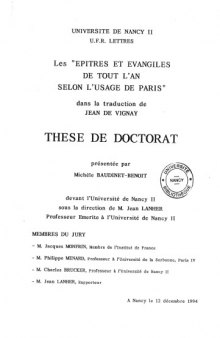 جزییات کتاب
جزییات کتاب
En ce début XIVème siècle, Jeanne de Bourgogne, épouse de Philippe de Valois, alors roi de France, commande pour son usage personnel un recueil de textes scripturaires présentés suivant l'ordre liturgique du missel utilisé à Paris. Cette démarche est originale pour plusieurs raisons : le recueil n'entre pas dans les catégories répertoriées, et son usage est nouveau. De plus, la langue choisie par la reine, le français, témoigne d'une volonté de participer à ce mouvement latent qui conduira une langue vulgaire à devenir une langue de culture. Pour ce faire, elle requiert les services de Jean de Vignay, un des plus célèbres traducteurs de son temps. C'est pourquoi, j'ai choisi de présenter une édition des "Epîtres et Evangiles dans la traduction de Jean de Vignay". Cette édition comporte une transcription, la plus fidèle possible, de 231 épîtres et 177 évangiles, reliés en 155 folios. Ce travail se complète de nombreuses notes critiques qui peuvent éclairer l'oeuvre du traducteur. Comme il est d'usage, j'y ai joint une table de toponymes et d'anthroponymes, ainsi qu'un glossaire. D'autre part, une étude détaillée du manuscrit conservé dans le département des manuscrits de la Bibliothèque Nationale sous la référence : nouv. acq. fr. 4508 (XIVe) se retrouve dans ma recherche ; elle pourra contribuer à l'élaboration de bases nécessaires aux spécialistes, qu'ils soient linguistes ou historiens de l'art.In the beginning of the XIVth century, Jeanne de Bourgogne, wife of Philippe de Valois then King of France, commissioned an anthropology of religious manuscripts for her own personal use. This anthology was set out following the liturgical order of the missal then in use in Paris. This approach was original for several reasons : the work is not listed in any of the catalogues for the period and its intended use was novel. Moreover, the language chosen by the Queen, french, demonstrated a desire to contribute to the latent movement which turned a language of the people into a language of culture. To achieve this, she engaged the services of Jean de Vignay, one of the most famous translators of his time. It is for these reasons that I have chosen to present this work, an edition of the "Epistles and gospels for the whole year, as translated by Jean de Vignay". This edition, bound in 155 folios, contains the most faithful possible transcription of 231 epistles and 177 gospels. The work has been supplemented by numerous critical notes seeking to clarify the work of the translator. As is customary, I have added an index of toponyms, an index of anthroponyms, and a glossary. Furthermore, my own detailed study of the manuscript (kept by the department of manuscripts of the Bibliothèque Nationale under the reference : nouv. acq. fr. 4508 (XIVe) is included here in the hope that it may serve as a useful source for specialists wether they be linguists or art historians. Read more...



 دانلود کتاب
دانلود کتاب

 جزییات کتاب
جزییات کتاب





 این کتاب رو مطالعه کردید؟ نظر شما چیست؟
این کتاب رو مطالعه کردید؟ نظر شما چیست؟
